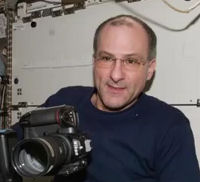Written by Dr. Tony Phillips
Science at NASA
 Washington, D.C. – This weekend, NASA scientists, amateur astronomers, and an astronaut on board the International Space Station will attempt the first-ever 3D photography of meteors from Earth and space.
Washington, D.C. – This weekend, NASA scientists, amateur astronomers, and an astronaut on board the International Space Station will attempt the first-ever 3D photography of meteors from Earth and space.
“The annual Lyrid meteor shower peaks on April 21st-22nd,” says Bill Cooke, the head of NASA’s Meteoroid Environment Office. “We’re going to try to photograph some of these ‘shooting stars’ simultaneously from ground stations, from a research balloon in the stratosphere, and from the space station.”
Lyrid meteors come from Comet Thatcher. Every year in late April Earth passes through a stream of debris from the old comet, which has been bringing Lyrid meteors to our planet for at least 2600 years. Specks of Thatcher’s dust hit the top of atmosphere at 110,000 mph and disintegrate in a flurry of meteors. Most years, the shower produces about 15 to 20 Lyrids per hour.This is a good year to look for Lyrids because the Moon will be new when the shower peaks. Dark skies favor sightings both from Earth and from Earth orbit.
“Even though the Lyrids are not noted for spectacular rates, the combination of a New Moon and a very favorable viewing geometry from the International Space Station (ISS) presents a unique opportunity to simultaneously image shower meteors from above and below,” says Cooke.

ISS Flight Engineer Don Pettit will be operating the camera on the space station.
“Even though his equipment was designed for tasks other than meteor observing, Don is a skilled astrophotographer, and we have every confidence that he will maximize the chances of capturing a Lyrid from 400 km above Earth’s surface.”
As the Space Station passes over North America multiple times on the night of April 21st, a network of all-sky cameras–some operated by amateur astronomers and others by NASA–will be recording the shower. In Bishop, California, a group of high school and middle school students will launch a helium balloon to the stratosphere. The payload floating some 40 km above Earth’s surface will carry an experimental low-cost meteor camera and recorder developed by the Meteoroid Environment Office.
As astrophotographers know, catching a fleet meteor with a single camera takes some luck. Catching one meteor with multiple cameras, some of them on platforms moving as fast as 17,000 mph, scattered from Earth to Earth orbit, sounds more like winning the lottery.
“Actually, we think the odds are fairly good,” says Cooke, who estimates a 1 in 6 chance of a simultaneous catch between the ISS and one of the wide-field ground cameras.If the effort does produce 3D imagery of any Lyrids, Cooke plans to use the photos to test ideas and algorithms for processing date gathered by future space-based meteor observatories. “We’re laying the groundwork for small satellites that might one day be used to monitor meteor showers from Earth orbit,” he explains.
Cooke encourages sky watchers everywhere be alert for meteors this Saturday night. Typical Lyrids are about as bright as the stars of the Big Dipper, so they’re good for beginners. And it’s not unusual to see one or two fireballs when the shower peaks. A good time to look is during the hours after midnight, when the shower’s radiant is rising toward its zenith.
Although the Lyrid meteor rate is usually capped at 20 per hour, better displays sometimes occur when Earth glides through an unusually dense clump of debris. In 1982, for instance, astronomers counted as many as 90 Lyrids per hour.
“Such an outburst would be great for our experiment,” says Cooke.
Amateur astronomers who wish to help monitor the 2012 Lyrids are encouraged to download the Meteor Counter for iPhones. The app records meteor counts and reports the data to NASA for possible analysis.
Also, Cooke and colleagues will be “staying up all night” on April 21st to chat with the general public about the shower. Tune in at www.nasa.gov/connect/chat/


